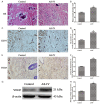Multifaceted effects of astragaloside IV on promotion of random pattern skin flap survival in rats
- PMID: 28979690
- PMCID: PMC5622259
Multifaceted effects of astragaloside IV on promotion of random pattern skin flap survival in rats
Abstract
Random pattern skin flap transplantation is frequently applied in plastic and reconstructive surgery, but the distal part of skin flaps often suffers necrosis due to ischemia. Astragaloside IV (AS-IV), a natural saponin purified from Astragalus membranaceus, may have beneficial functions for flap survival. In this study, rats were divided into a control group and an AS-IV treatment group, and underwent surgery using a modified "McFarlane flap" model. After intragastric administration of vehicle control or AS-IV for their respective groups, flap survival area and water content were measured 7 days after surgery. Flap tissue was separated to test protein expressions related to angiogenesis, inflammation, oxidative stress and autophagy via western blot, immunohistochemistry, and immunofluorescence. Results showed that AS-IV improved flap survival area and reduced tissue edema. AS-IV also increased mean vessel densities and upregulated levels of VEGF protein, both of which indicate increased angiogenesis. Furthermore, AS-IV depressed leukocyte infiltration, decreased expressions of inflammatory proteins TNF-α, IL1β and IL6, increased SOD activity, decreased MDA content, and stimulated autophagy. Overall, our results suggest that AS-IV promotes skin flap survival via inducing angiogenesis, depressing inflammation and dampening oxidative stress; it also activates autophagy, which may be an underlying mechanism for oxidative stress depression.
Keywords: Astragaloside IV; angiogenesis; autophagy; inflammation; oxidative stress; random skin flap survival.
Conflict of interest statement
None.
Figures





References
-
- Sen H, Oruc M, Isik VM, Sadic M, Sayar H, Citil R, Korkmaz M, Kocer U. The effect of omeprazole usage on the viability of random pattern skin flaps in rats. Ann Plast Surg. 2017;78:e5–e9. - PubMed
-
- Kailiang Z, Yihui Z, Dingsheng L, Xianyao T. Effects of muscone on random skin flap survival in rats. J Reconstr Microsurg. 2016;32:200–207. - PubMed
-
- Stell PM. Proceedings: the influence of retraction on the viability of a skin flap. Br J Surg. 1976;63:669. - PubMed
LinkOut - more resources
Full Text Sources
Research Materials
